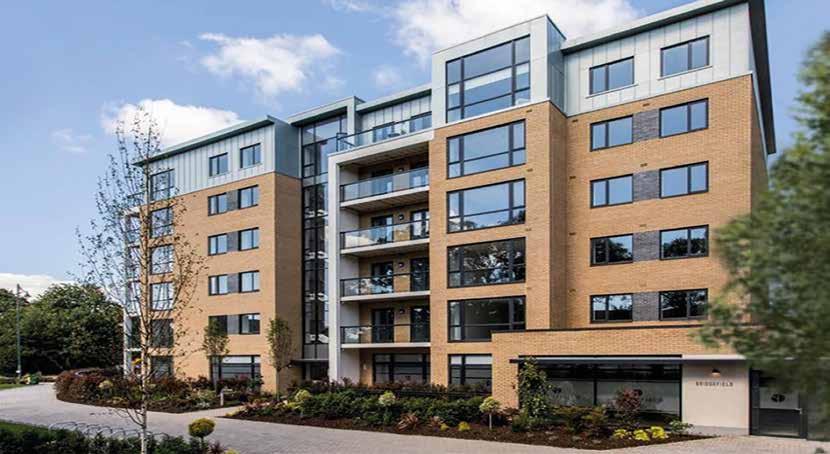SUSTAI NABI LIT Y
House builders need to ac t now to take the lead in addressing e m b o d ie d c a r b o n in f u tu r e d e v e lo p m e nt s Susan McGarry, Managing Director, Ecocem Ireland.
A
SUSAN MCGARRY, Managing Director, Ecocem Ireland, writes about how the revised Climate Action Bill has forced a significant rethink on the materials that will go into our future buildings.
s full construction returns, Ecocem Ireland’s focus is firmly set on the government’s future residential development plans. Forecasts consistently indicate that 35,000 new homes are needed each year for the next 20 years, or 700,000 new units in total. This target will be a real challenge to achieve. But now, the need for developers to reduce embodied carbon in buildings is an additional factor to increase the challenge. In recent years, the focus has been on operational costs of buildings and has been reflected by several iterations of Part L of the building regulations. Though this area will continue to be scrutinised, there will also be a much greater focus on the embodied carbon of buildings. Specifiers and developers will be challenged to reduce embodied carbon on new developments, and this can only be achieved through the specification of low carbon materials. Carbon reduction objectives have been incorporated into the revised Climate Action Bill, and a significant rethink will be required to meet reduction targets in the built environment sector.
SUSTAINABLE CONSTRUCTION
With the increase in housing output over the coming years, sustainable construction will be crucial in reducing carbon emissions. Local authorities will be required to set and adhere rigorously to their specific carbon budgets. These challenges will also apply to centrally-funded government projects. Research has shown that the average embodied carbon of construction materials used in new residential housing and apartment developments is around 30 tonnes of CO2 per dwelling. Traditional cement-based products account for roughly half of this carbon. Therefore, a significant step can be taken to reduce this figure by specifying low-carbon cement in all concrete products. This includes ready mix concrete, traditional blocks, precast concrete, and mortars. Founded in 2003, Ecocem is an Irish owned company and Europe’s largest independent producer of ground granulated blast-furnace slag (GGBS), a recycled by-product of the steel industry that contributes to the circular economy by replacing up to 70% of the cement required in concrete. In Ireland, GGBS is predominantly used in ready-mix and precast concrete. Ecocem has invested in innovation and is enabling the adaption and increased usage of GGBS in other products, such as blocks, mortar, and, more recently, soil stabilisation.
SUSTAINABLE INNOVATIONS
Soil stabilisation is an exciting example. Traditionally, unsuitable soil would have been removed from building sites and transported to landfill. Replacement soil would then need to be located and supplied to site, facilitating a considerable increase in site traffic and disruption around multiple locations. It is becoming more common
Low-carbon blocks from Coshla Quarries with 50% Ecocem. in recent years to treat the soil on site to enhance its composition and make it suitable for use. The most common solutions involve mixing the soil with Portland cement or a cement/quicklime blend to increase the structural performance and stabilise chemical impurities. However, recent studies have shown that environmental and technical performance can be enhanced significantly by replacing high percentages of these additives with GGBS.
ENVIRONMENTAL PRODUCT DECLARATIONS
Ecocem GGBS carries its own Environmental Product Declaration (EPD), an independently verified and registered document that communicates comparable information about the life-cycle environmental impact of products. With a CO2 value of 32kgs per tonne compared to Ordinary Portland Cement (OPC) at 802kgs per tonne, Ecocem GGBS has been shown to significantly reduce the embodied carbon of concrete while delivering numerous technical benefits. GGBS increases the strength, durability, and chemical resistance of concrete, to name but a few and can be utilised across all traditional cement applications. When Ecocem GGBS is used at high cement replacement rates, the savings are notable (up to 67% in some applications). As cement accounts for around 90% of the embodied carbon of concrete, it is clear why many specifiers have switched. We have now entered a new world of low-carbon building and living, and the changes required are urgent and immediate and are part of Ireland’s commitment to carbon neutrality by 2050. For more information on improving your mix designs and overall carbon reduction on your next project, contact Don Davern, 086 2509015, email ddavern@ecocem.ie or visit the Ecocem website www. ecocem.ie.
irishconstructionnews 55 May 2021

















